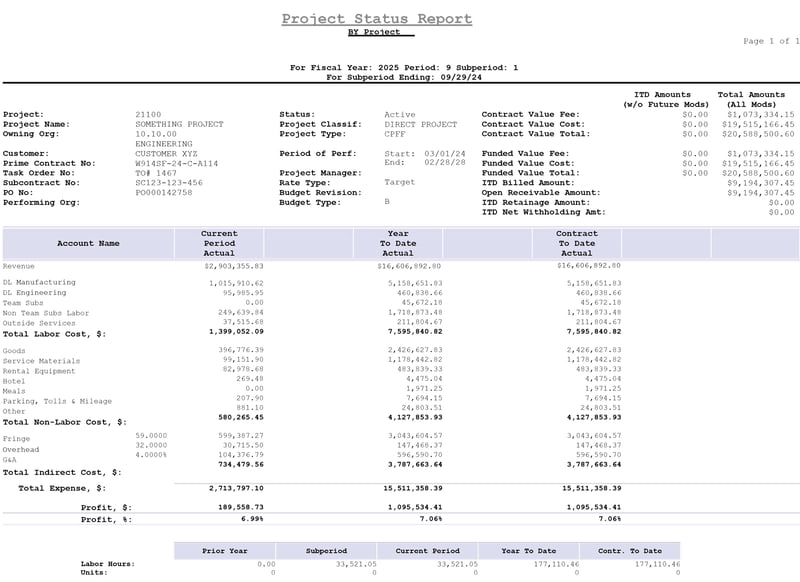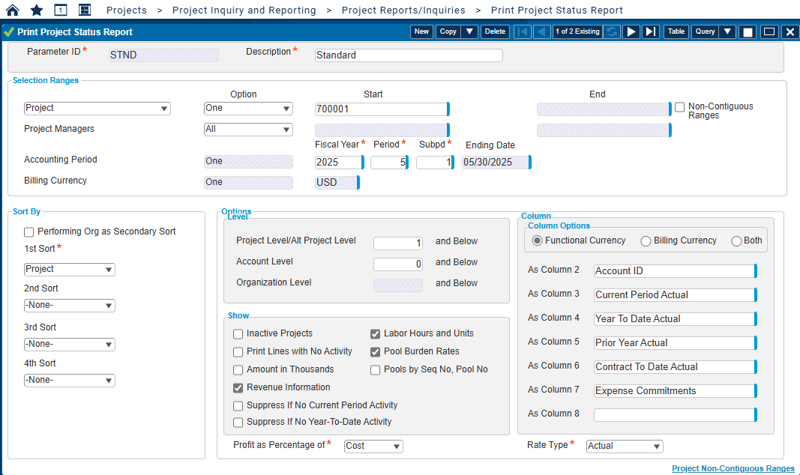
Project status report (PSR), job status report, project summary, many names for the same thing…a report that gives the user a summary of the information associated with a project. The project status report in Deltek’s Costpoint is a snapshot of a project's current status at any given time. It contains data from many different sources and is useful to Accounting, Project Management, and Leadership to assess the current position of a project or contract. This report has a range of options to provide users with the specific information related to the project they would like to review.
Why Use the Project Status Report (PSR)?
The project status report in Deltek’s Costpoint shows all your basic project information in one report. By using the information contained within the different sections of the report, users can both monitor the progress of the project and also use the information to make important and timely decisions. Additionally, PSRs are an often-requested artifact by DCAA in assessing a program or running audit procedures, so it is important to become familiar with these reports and to review them monthly to ensure they are accurate.

The header section of a PSR has overall project information, most of which remains static. This includes identification numbers related to the project, like contract number, subcontract number, and PO number. It also includes company information like the project status, project type and owning organization. But the header information also includes data that gets updated over the life of the project, and it is important to review. The PSR gives the latest data for:
- Period of Performance: This section of the header area gives the most current start and end dates for the level of project being viewed. Looking at the top level of a project will show the full period of performance for the whole project. With a simple glance at this report, users can identify if they are within the period of performance, outside the start and end dates, or getting close to the end. With this information, users can evaluate whether work on the project that remains to be finished will fit within the remaining timeframe.
- Contract and Funding Values: The header section also provides the current and future contract and funding values based on the modifications entered into Costpoint. Using the effective date associated with recorded modifications, this report is useful to evaluate the impact of upcoming contract modifications on the current status of projects. By comparing this contract and funding value information to the data provided in the detailed section of the PSR, users can determine if contract and funding values will be sufficient for the remaining work.
- Billing Information: The current open receivable amount and inception-to-date billed amounts are also available in the header section. This provides the user a quick view of billing compared to contract or funding values, and whether there is a large receivable associated with the contract. This information can help users determine if the amounts not yet billed will be sufficient to cover remaining work, or if large receivables are present, if evaluations need to be done on the risk of further non-payment.
The detail section of a PSR has financial information chosen by the user and which is specific to a fiscal year, period, and subperiod selected. This information is a summary of the cost transactions that have been posted to the project for the selected time period. This information is important for decision-making and answering questions associated with the project.
- Cost by Category: The detail section presents information in sections of labor, non-labor, indirects and profitability. Each of these has important factors for decision-making.
- Are labor costs above expected or budget?
- Are there unexpected non-labor charges?
- Indirect Pools/Burdens: In the detail section, each pool or indirect rate affecting the project is listed with the applicable allocated amount. Many times, people focus on the cost that hits a project, but the burden amounts can be just as important.
- Are the rates above target?
- If so, what is the impact on the budget?
- Profitability: As mentioned above, a lot of focus is on cost, but with each cost there is a burden applied, so looking at just a list of costs is not enough. The detail section of the PSR provides profitability numbers and percentages that take those indirect costs into consideration. This allows users to see the actual profit associated with a project.
Before wrapping up why using the Project Status Report is helpful, two items of note. Shortly, we will discuss how to run the PSR, which includes selecting the columns to include. There are two general items that can be especially useful if you are using specific modules within Costpoint.
- Commitments: As outlined below, there are several column options to include different purchasing commitments on the PSR. This is very useful if the Procurement module within Costpoint is being used, as it can include outstanding requisitions and/or purchase orders that have not been processed through Accounts Payable. This allows the user to see not just those purchases that have hit the project, but those for which a purchase commitment has been made. This is very important when looking at the actual remaining contract or funding value.
- Budget Amounts: Also listed below are options for including budget amounts on the PSR. These are available if a company is using either the Planning module or older project budgeting within Costpoint. This can be very helpful to see how revenue, current costs, indirects and profitability are measuring up to expectations.
- Are adjustments to a forecast needed?
- Does an overrun need to be addressed?
How to Run a Project Status Report
There are many options for running a Project Status Report. It is important to take time to customize the PSR in a way that makes sense to end users. Likely, different views will be needed based on someone’s role in the company. Saving the different views as report parameters (templates) drastically streamlines running the report and standardizes the output.

- Selection Ranges [Top]: Use this section to select the accounting period and subset of projects, project managers, or organizations to include on the PSR. If the company uses special project types, like WIP projects or alternate projects, using the drop-down allows you to pick other options to filter the results.
- Sort By [Left]: Multiple options are available for sorting the output, and sorting can be layered.
- Options/Levels [Middle]: Choose the project, account and potentially org level to include on the report. You might choose to view projects at the transaction level, the revenue level, the top level, or any other level in between. The same can apply to accounts and orgs. Level 0 can be used to indicate including whatever level the transaction(s) occurred.
- Options/Show [Middle]: This section provides multiple options of additional information to include with the report or within the selection. For example, you can choose to include the indirect rates on the report, and/or choose to exclude any project that does not have activity in the current period. Please note that the default is to exclude inactive projects. If the report is being used to review all projects regardless of status, you will need to select this option to view inactive project information.
- Columns [Right]: This section provides numerous options for the eight (8) columns available on the report. These columns include categories in the following:
- Time Periods: Current, Year to Date, Prior Year, and Contract to Date. These are available for actual amounts, budget amounts and/or the variance between those two.
- Commitments: Commitments at many stages in the procure-to-pay lifecycle are available for selection. These include requisitions at different stages of approval and purchase orders at different stages of receipt and/or processing.

- Other [Bottom]: These bottom selections can be very important for the data that is displayed. The option for rate type determines if calculated actual rates or the entered target rates are used within the report. A third option is available to view indirects on costs at actual rates and revenue at the target rate. Also, the calculation of the profit percentage can be based on cost or revenue.
What Are the Drawbacks or Errors with the Project Status Report?
Errors
A common error when running the PSR is a mismatch between the project selection entered and the project level selected. For example, if the project selection is set to include a project code at level 3, but then the project level under the options is set to 1, an error will occur. This resulting error message will state, “The starting level value is lower than the specified level.” To fix this, either change the project entered in the “selection” area or change the project level in the “options” area.
The timing of the report is important to ensure that all data presented is accurate. Suppose the report is run before important processes, such as compute burden, compute revenue, or update project status report tables. In that case, it could be missing data and/or present no data at all. It is important to use either the “Reporting Processes” screen to update all the necessary processes or run each process separately.
Drawbacks
A drawback to using this report is that it can only be run for a single fiscal year, period and subperiod. Therefore, it cannot provide a trend or view of project data over time. To view trend project information, a report in the Business Intelligence module can be developed.
Because the report only gives an option for including indirects on cost at either target or actual, it cannot be used to compare the difference. The report cannot show what the total expense or profitability would be at both on the same report for comparison. To view a comparison of target versus actual profitability, a report in the Business Intelligence module can be developed.
It is important to remember that this report is a snapshot in time. If it is run before accounting has completed capturing all costs, computing revenue, and computing pools, the final data for that month may be different when run after entries have been completed.
Why the Project Status Report Matters
The Project Status Report is one of the most important reports in Costpoint and is often requested by name by customers or auditors. It contains vital project information used to make decisions, detect errors, and assess the overall project health. Different views of the report can be established for different stakeholders to allow each to see the information as more important to them. Understanding and reviewing the Project Status Report can be vital to tracking and verifying project information.
Supporting Effective Project Reporting and Compliance
Understanding how to effectively use the Project Status Report in Deltek Costpoint is essential for accurate project tracking, internal decision-making, and meeting external audit expectations. Redstone GCI supports government contractors with system configuration, reporting setup, and ongoing training to help ensure data integrity and compliance. Our Custom Reporting and Data Analytics services also help clients develop tailored reports and dashboards that align with their specific project management and compliance needs. Whether you need assistance customizing your PSR views, integrating financial data, or navigating reporting requirements, our team is here to provide the technical and regulatory guidance your projects require.

